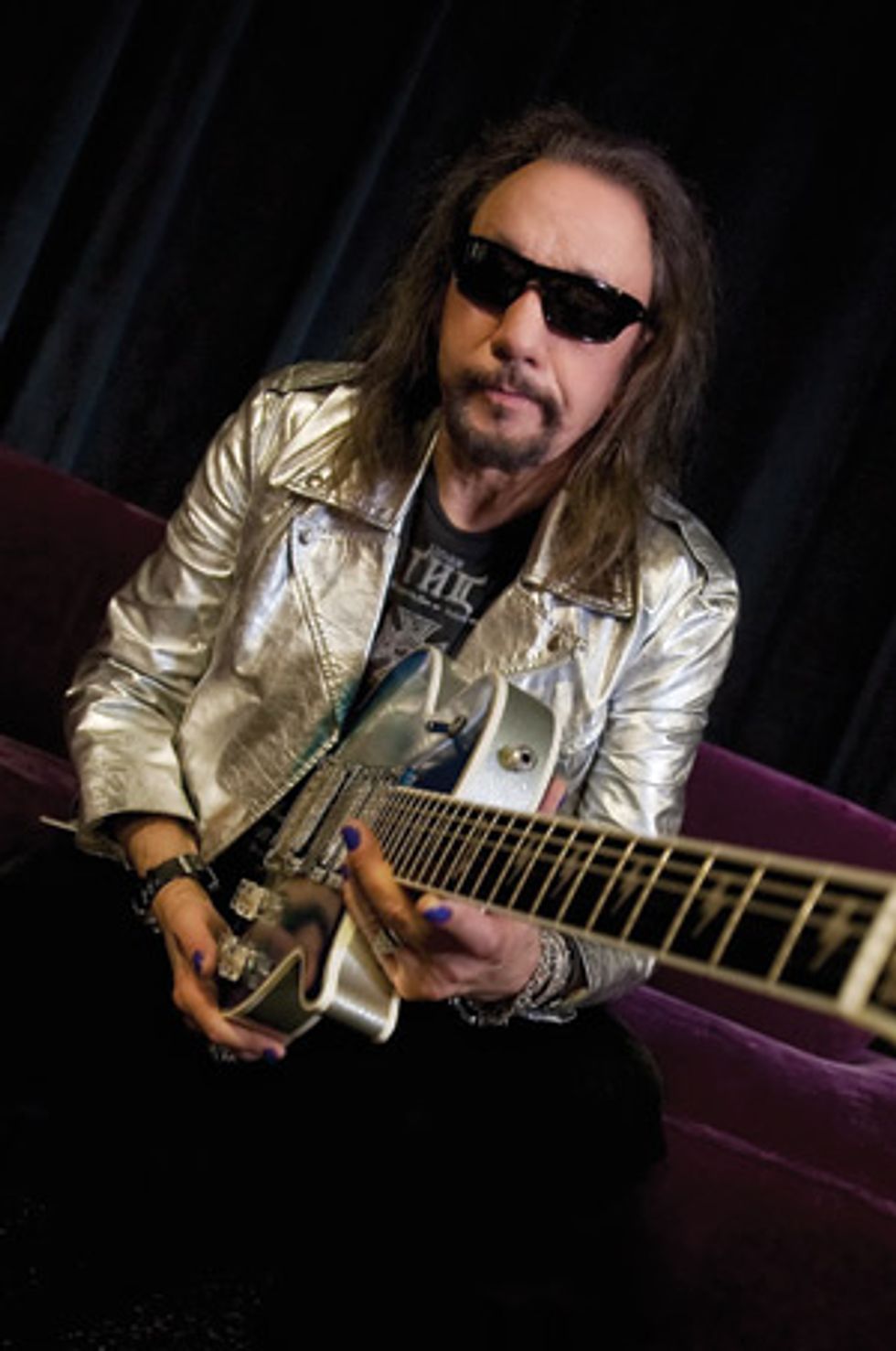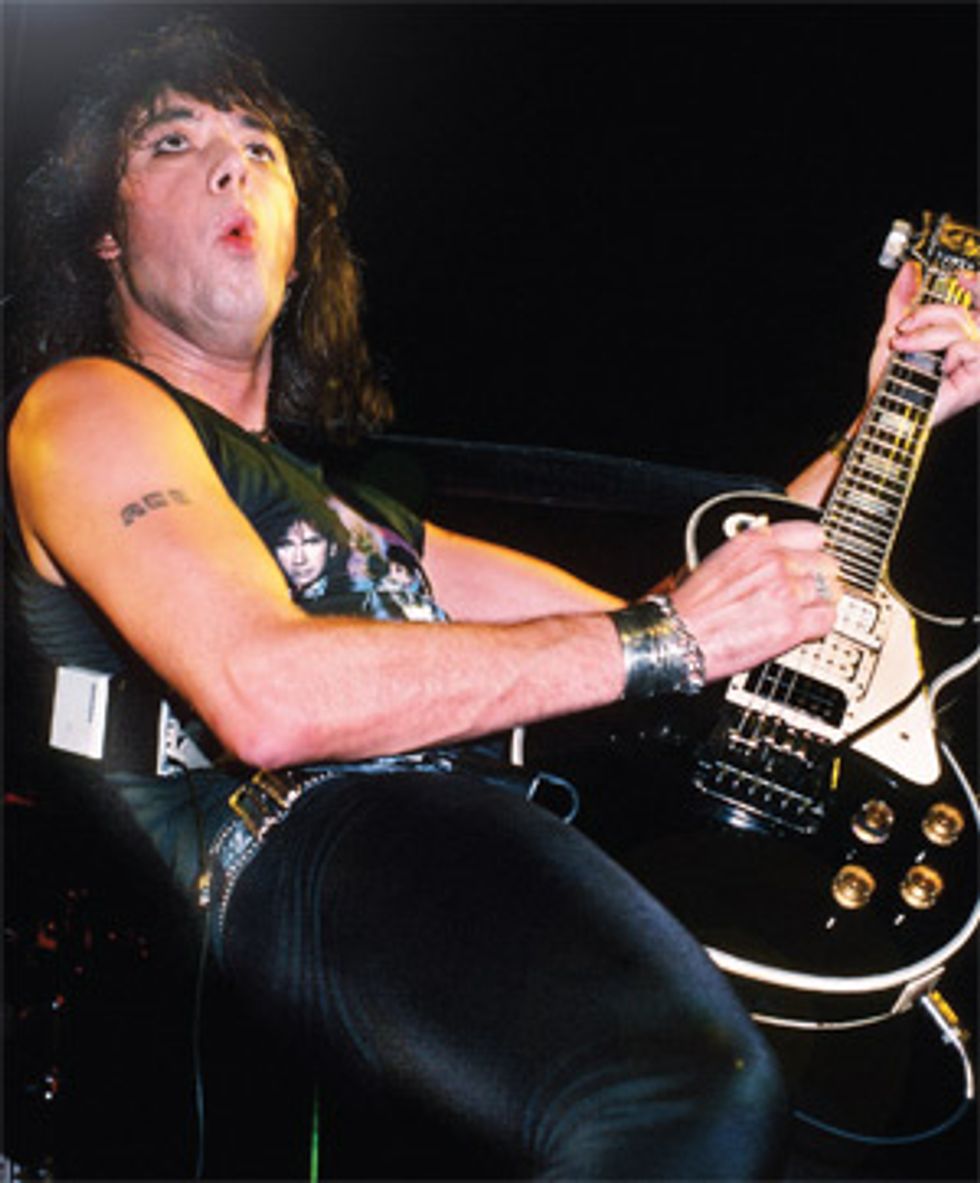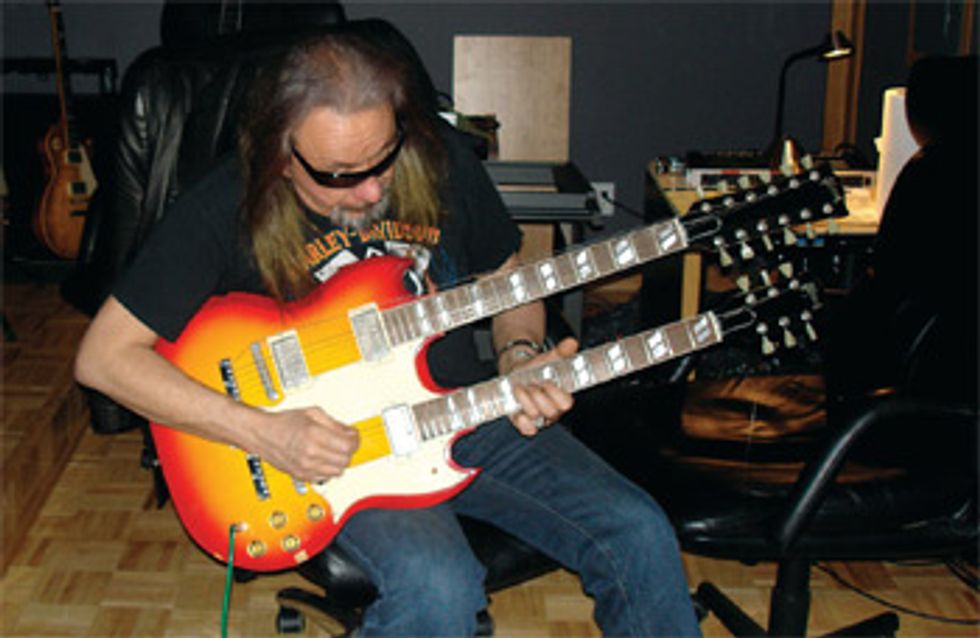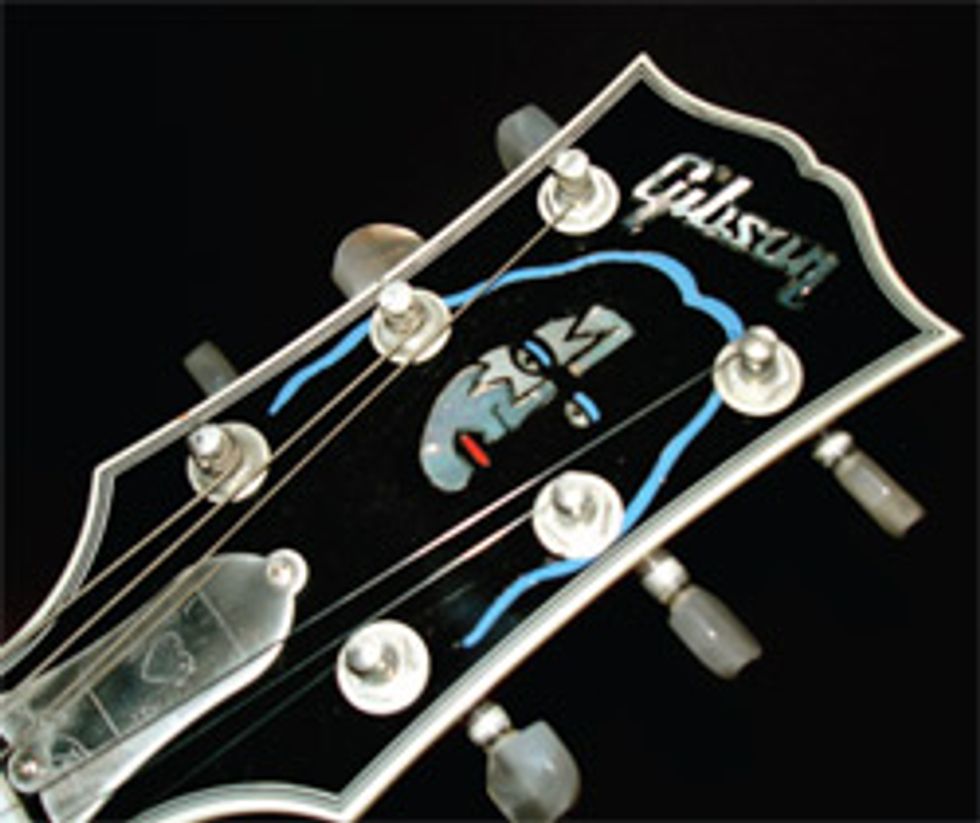Engineer Rich Tozzoli Talks with Ace Frehley about His New Album, Anomaly
|  |
Having been one of the engineers who helped capture his new sound on Anomaly, I was able to get to know a different guy than the stage persona known to most of the world. Ace, who also produced the album, is celebrating his third year of sobriety, and you can tell: a deep passion for all things guitar shines through on this record. Forever experimenting and always open to new sonic ideas, he carved out a hard-hitting record that reminds many of his 1978 eponymous solo debut.
I caught up with Ace between tours to reflect on the making of Anomaly, his influences, and what lies ahead for him.
When you were getting ready to record parts for Anomaly, you often walked around the studio playing the guitars unplugged. What were you listening for?
That’s what I do when I first buy any electric guitar. I always try to hear what the instrument will sound and feel like without any amplification. I discovered that when you’re shopping for a Les Paul, Strat or Tele, nine times out of ten, whichever one is louder and feels like the whole body is resonating, that one usually sounds better through an amp. Also, when you’re not sure how old the strings are, it’s real apparent that they’re not bright if you play without an amp.
Sometimes we used big heads with a cabinet, and sometimes we used small amps. From a playing and recording point of view, what does each give you?
I’ve always fooled around with little amps, even as early as the first Kiss records. I’d use them in combination with a 4x12 or a Marshall stack. It works well when you blend those sounds together. As much as everyone tries to recapture or fabricate a Marshall stack with a plug-in or whatever, there is nothing like the real thing. So when you combine big and small amps, you simply get a variety of tones. Small amps bring different textures that can’t be replicated, either.
 Ace performing in Detroit, Oct. 31, 1987. Photo by Ken Settle. |
Yes. I guess I’m pretty much a purist. I really want what’s coming out of the amp to go into the computer or whatever we’re recording on. Once it’s in there and it’s right, you can always tweak it with plug-ins or by pumping it out again and re-recording. But when you get a really good amp sound direct, it can help you give a really good performance. The most important thing is capturing that performance, and if we need to change the tone a little bit, we can effect it down the road.
How did you decide on using the blend of Les Pauls, Strats and Teles?
I’ve been doing that since my first solo record. I had a couple of old Teles and Strats lying around, and I discovered it just created a great blend. Since they all have completely different harmonic ranges, they can create a much fuller sound when mixed in with each other. You can also get a lot of different sounds, depending on how you split them in the mix. I also discovered that I’ll play something slightly different on a Strat or Tele than I would on my Les Paul, simply because of the difference in the body and fingerboards. If you double something on each of those guitars, it’s slightly different in the way you finger it. When you put them together, that little difference makes it that much better. I remember recording Destroyer with Bob Ezrin, and he told me to knock my guitar a little out of tune before I did a double because the frequencies would make a rub with each other. And it really worked!
Let’s talk about that unusual, resonating doubleneck sound you got on your new version of “Fractured Quantum.”
I discovered that with Eddie Kramer when I was doing the original “Fractured Mirror” on my ’78 solo album. We had a room filled with amps and the control room was outside the Colgate Estate in a Fedco truck mobile unit, so we could use all the amps without worrying about feedback—because the control room was so remote. I remember turning everything up to 10 on a lot of different amps. One day, I happened to be playing the doubleneck and I didn’t have the other neck’s pickup off—I forgot which neck I was playing. It was all coming out of the amp through the other pickup, too, even though I wasn’t playing that neck. It had this really cool bell sound. And if you remember, we kept making notes while we were recording “Fractured Quantum” this time so I would remember to use that effect again. It was just something I stumbled upon by accident— the way most inventions happen.
We also used a 7-string, a guitar in Nashville tuning and several 6- and 12- string acoustics.
I got that idea of layering acoustic guitars from Pete Townshend. If you listen to early Who records, even the electric songs sometimes have acoustics tucked underneath. That’s why I started experimenting, not only with Teles and Strats along with my Les Paul, but also with acoustics. Sometimes you can put one in a rock song and not have it loud, just underneath. It adds a fullness that you don’t really hear until you take it away. When you listen to the song, you think it’s all electrics. Songs like “Genghis Khan” and some of the others have that sound layered in there.
“Genghis Kahn” also has an alternate tuning, doesn’t it?
Yeah, the rhythm-track tuning is just something I came up with one day. I raised the high E up to F#. It makes a very cool chord sound, especially in the G position. For the intro, I just downtuned a bunch of strings and recorded the intro separately, I don’t even remember what I did! Maybe Alex wrote it down when we did it. Will Pang also helped me do another track on that song one night. There are so many tracks!
On “It’s a Great Life,” you went in a new direction with the solo.
I usually come up with solos that lend themselves to the type of song they’re in. This one went off in left field because I’ve never written anything quite like that song. The first thing that came to mind was playing around with an octave run, kind of like a jazz player. We also used a small, old Fender amp with a Jensen speaker, and that made it that much cooler sounding.
One thing I noticed working with you was the strength of your rhythm playing. How did you develop such a solid feel?
I was really inspired by Keith Richards, but even more so by Pete Townshend. I was such a huge fan when I was a kid, and I used to sit next to the record player and figure out every Who song. What amazed me was the way Townshend did his multiple strums. Playing a lot of Who music really helped develop my right hand, which helped with not only my rhythm technique but my leads, too. I remember also—though I haven’t thought it about in years—I used to hang out with this crazy black dude when I was a kid. I was about 15 and he was 22 or so. We used to play in the veterans hospital on Kingsbridge Avenue in the Bronx. He loved the Stones, and I would go over there with him and a drummer, and he made me play the same song over and over for like half an hour! He’d dance and sing and go crazy to the point where my hand was falling off. We weren’t getting paid. We were just trying to make these guys happy. Since I was the only guitar player, I couldn’t play a lot of lead, so by the end of the set my hands hurt. But I have to thank him for that, because he pushed me and it just made me a stronger, better guitar player.
 Ace with his doubleneck tracking “Fractured Quantum.” Photo by Rich Tozzoli. |
I met Anton around the time I was putting songs together for my first solo album when I was with Kiss. He had only been in the country for a few years, because he’d grown up in Cape Town, South Africa, and had been around that amazing beat his whole life. Eddie Kramer heard his demos and asked if he wanted to work with me. Ironically, I had another friend, Larry Russell, who also heard Anton play and came to me independently and said he had a great drummer for me. To me, that’s karma, so I jumped at the chance to jam with him. We’ve been close friends ever since. The greatest things about Anton are his fills and the space he leaves. He doesn’t try to fill up everything, and I really like the fact that he plays slightly behind the beat, à la John Bonham. A lot of drummers play on the beat, and when they get excited and the adrenaline is pumping they play ahead of the beat, which gives some songs a nervous feel. I like to have a relaxed feel, and Anton always holds the song back with a solid rhythm. Me and Anton have been playing so long together we almost have this telepathic communication, where I’ll think something and he’ll do it, or I’ll just look at him and he’ll know what I’m thinking. Things come together so quickly, and it’s just a joy to work with him.
You used some of the players in your live band on the record as well, didn’t you?
Yes. When we first started tracking at Schoolhouse Studios, Anthony was a big part of putting this all together. I developed a lot of these songs with him. He’s a real strong bass player and added a lot to these songs, as did Anton Fig. Then we moved up to Ace In The Hole Studios, and it was a whole different mix. Derek Hawkins, who plays guitar with me, helped a lot when we started tracking there. He helped me think through a lot of the parts, and he showed me the dropped-D tuning for “Outer Space.” Derek also did the slide runs on that song, which sound great. He laid down the original bed track of that song and really helped with it. Scot Coogan, who also plays drums with me live, sang background on “Pain in the Neck.” He really helped me with “Sister,” which he also played drums on and sang on. Scotty is more of a live drummer, and he really bought that track up.
Sometimes you liked to track in the control room and sometimes in front of the amps. Why?
Well, you play differently when you’re standing in front of an amp and are bombarded with the sound, especially if it’s loud. It’s great, but sometimes you struggle with hearing the track in the headphones. Actually, sometimes I don’t care if I can hear the track, as long as I can hear the beat. But, most of the solos I chose to track in the control room, because I wanted to hear what was going into the computer. It’s a little less insane, too. There are advantages to standing with the amp, but there are advantages to sitting in the control room, if you know that what you hear through the speakers is the real sound. When you’re out in the room, you’re not exactly sure what the recorded sound will be.
How was it working with different engineers on various parts of the record?
The basic tracks were recorded at my live bassist Anthony Esposito’s Schoolhouse Studios on 27th Street in New York. It’s really live feeling in there, and Jay Messina did those tracks. Working with Jay is always great, because I’ve done so many projects with him, going back to Destroyer and so on. He always adds something with the way he mikes things, and his room miking technique with drums gives you more flexibility when you’re mixing later on. So that was a great way to kick off the album. Then I moved everything up to my studio in New York, which is a different room sound, with different gear and so on. That’s when I started working with you and Alex Salzman and Tim Hatfield. All of you guys added something special. When it came to tracking guitar solos, I thought working with you was probably the most exciting, because when I started playing great solos and getting great sounds it made you excited, which would make me more excited! It was a good marriage there, and you kept pushing me to do more takes. Those were probably some of my best solos. Marty Frederiksen also mixed the record and did some engineering, in addition to playing bass and singing backgrounds on “Fox On The Run.” He really helped the guitar parts breathe better. But everybody did a great job. I learned so much by watching you guys on Pro Tools. It’s the best education I could have gotten. It’s not only a good feeling to be more knowledgeable now, but it also helps me because now when I go into a studio with an engineer I’ve never worked with before, I know whether they’re doing it right or not! When I think about editing, say back with Eddie Kramer and Bob Ezrin, it was all on two-inch tape. We’d have to slice the tape and put it back together to see if it worked. If it wasn’t cut exactly where we wanted, we’d end up with little slices of tape all over the machine. It was such a nightmare. Now, it’s amazing. I really appreciate how great it is to edit with programs like Pro Tools.
 Ace Frehley Signature Gibson Les Paul headstock. Photo by Rich Tozzoli. |
On “A Little Below the Angels,” I actually didn’t like my original vocal. I redid them because I felt like I was singing with almost a country twang. The more I thought about it, the more I wanted to change it, so I took the AKG mic one night at 5 a.m. and ran it through an Avalon preamp—I actually engineered it myself. It came out very natural and not pushed, because I was really relaxed. I just dropped it onto a portable hard drive and brought it out to LA for the mix. But I don’t actually like recording myself, because you have to think too much and it can take away from the performance.
Many people may not realize how into computers you are.
[Laughs] Yeah, I had the first Mac computer. I had one of the first IBMs and a Commodore, too. I was a kid when the whole computer revolution began, so I’ve always been into them. I had the first Radio Shack 4K computer— 4K! Imagine having a computer with 4K of memory! Back then, if you mentioned 4GB, someone would’ve thought it was for the military or outer space. We didn’t even talk about that much memory back then.
So what’s next for you?
Well, I finished a successful European tour, and I’m getting ready to go out again to Australia. Dates in the States will be coming up, and I’ll be doing festivals in Europe this summer. I’ve got a “Behind the Player” DVD coming out, and I’ve already been writing for the next record. I also plan on doing a cool DVD with computer animation that I’ll score. I pride myself on thinking outside the box, and I’m probably like that because I’m not a schooled musician. One of the reasons people may think I have a unique style is because I’m self-taught and make mistakes— or I do things in a way that, if I’d been taught by a teacher, they would’ve corrected. To me, there are no rules, and there never were.
acefrehley.com
ACE'S GEARBOX
According to the man himself, Ace’s rig both onstage and in the studio has always been relatively straightforward:
“On the early Kiss records, I used my tobacco sunburst Gibson Les Paul Standard with a rewound hot pickup, through a Marshall stack or old Fender tweed amp, on most of the studio recordings. I used an Electro-Harmonix Big Muff to overdrive them sometimes. Later, I got a cherry sunburst Les Paul Custom and an old ’59 Les Paul Standard, which dominated my studio recordings in the late ‘70s. My 1978 solo album, Ace Frehley, really shows off what a Les Paul guitar can do in the studio. I recorded almost the whole album exclusively with my 1959 vintage sunburst Les Paul. I use Gibson Les Paul Customs live because they’re simply the best guitars for loud rock ‘n’ roll. I’ve always said, ‘Just plug a Les Paul into a Marshall amp and turn it up to 10!’ It’s a no-brainer.”
